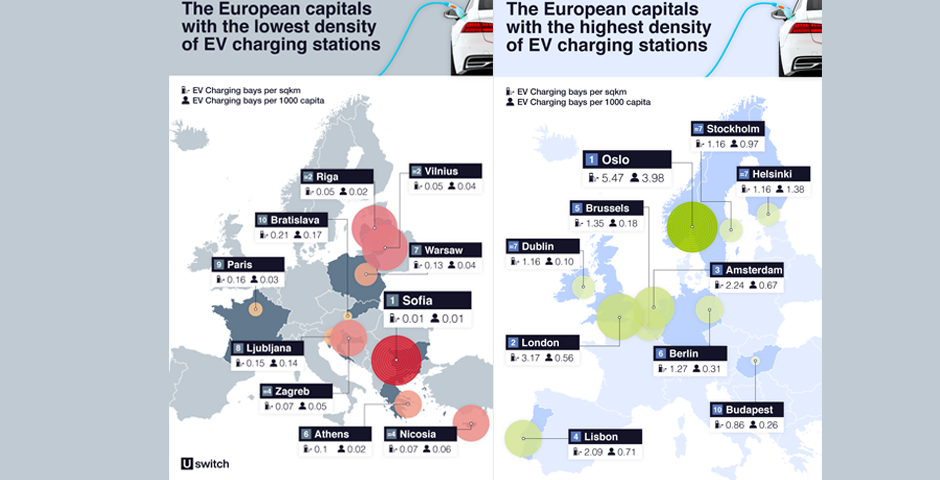With new research(1) indicating that over six in 10 motorists are concerned by the environmental impact of driving, it’s no surprise that 70%(2) of European drivers would consider an EV as their next car.
Intrigued by this, Uswitch.com/electric-car were keen to discover the European cities with the largest density of EV chargers. To do this, they analysed city population size alongside the volume of EV charging bays per km², and per 100,000 people.
With 1.27 charging bays per km², it can be revealed that Berlin, Germany has the sixth-largest EV charging density in Europe. The capital city has 1,134 EV charging bays, over thirty times that of neighbouring city Bern, Switzerland which ranks 18th place with only 37 bays. Berlin is home to 0.31 charging bays per 100,000 people, over double [51%] that of Vienna, Austria with only 0.15 per capita.
Oslo, Norway has the largest EV charger density in Europe with almost six [5.47] charging bays per km². The Nordic capital is home to 2,481 EV charging bays in total, 96% more than the number of chargers in Copenhagen, Denmark [95] despite having a similar population size. With almost four bays [3.98] per 100,000 people, the highest figure of all 31 European cities analysed, Oslo is the city most readily equipped for EV adoption in Europe.
With over three charging bays per km² [3.17], London, United Kingdom has the second-largest EV charger density in Europe. The British capital has almost 5,000 EV charging bays [4,991] in total, over 16 times the number of chargers in Paris, France [305]. London is home to 0.56 bays per capita, this is over three times more than Brussels in Belgium, with only 0.18. With the second-largest level of EV charging provision per km², it’s no surprise that EV uptake in the capital is increasing, with one in eight(3) new cars registered in London being electric.
Sofia, Bulgaria has the smallest EV charger density in Europe, with 0.01 charging bays per km². The capital city is home to only 15 charging bays, 87% fewer than neighbouring city Bucharest, Romania, with 121 in total.
With only 0.04 charging bays per capita, Vilnius, Lithuania has the second-lowest EV charger density in Europe. With 69% fewer than neighbouring city Warsaw in Poland [68], Vilnius is home to only 21 EV charging bays, only 0.05 bays per km². The capital city has just under half the number of charging bays in comparison to Tallin, Estonia, with 35 bays.
Riga, Latvia has the third smallest EV charging density, with only 0.02 charging bays per capita. The Latvian capital has 112 times fewer charging bays [15] than neighbouring city Stockholm, Sweden which boasts a staggering 1,693.
Ben Gallizzi, EV expert from Uswitch.com, comments: “When it comes to charging an electric car on the go, drivers can do so via an increasing number of public EV charge points located throughout city centres worldwide. It is worth bearing in mind that you may have to pay for some public EV chargers, so they are best used to top up the car's battery rather than charging it from empty to full.
Public charging points will usually charge at a 7 kW rate, providing about 30 miles of range per hour of charge (though some will charge at the faster rate of 22 kW). Public EV charge points can be paid for through an app on your phone, a dedicated electric car charging card or contactless payment depending on the provider.
For more information on charging your electric vehicle in public, visit our guide.”
The full dataset used throughout this study as well as a graphic for editorial use can be found, here.
Source: www.uswitch.com





